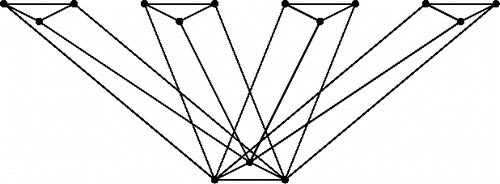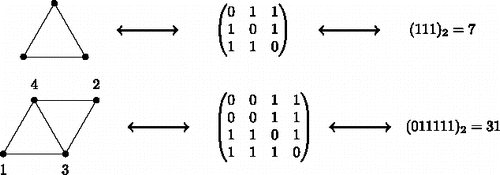 ?Mathematical formulae have been encoded as MathML and are displayed in this HTML version using MathJax in order to improve their display. Uncheck the box to turn MathJax off. This feature requires Javascript. Click on a formula to zoom.
?Mathematical formulae have been encoded as MathML and are displayed in this HTML version using MathJax in order to improve their display. Uncheck the box to turn MathJax off. This feature requires Javascript. Click on a formula to zoom.ABSTRACT
Computing the number of realizations of a minimally rigid graph is a notoriously difficult problem. Toward this goal, for graphs that are minimally rigid in the plane, we take advantage of a recently published algorithm, which is the fastest available method, although its complexity is still exponential. Combining computational results with the theory of constructing new rigid graphs by gluing, we give a new lower bound on the maximal possible number of (complex) realizations for graphs with a given number of vertices. We extend these ideas to rigid graphs in three dimensions and we derive similar lower bounds, by exploiting data from extensive Gröbner basis computations.
1. Introduction
The theory of rigid graphs forms a fascinating research area in the intersection of graph theory, computational (algebraic) geometry, and algorithms. Besides being a very interesting mathematical subject, rigid graphs and the underlying theory of Euclidean distance geometry have a huge number of applications ranging from robotics [CitationFaugère and Lazard 95, CitationWalter and Husty 07a, CitationWalter and Husty 07b] and bioinformatics [CitationEmiris and Mourrain 99, CitationJacobs et al. 01, CitationLiberti et al. 11, CitationLiberti et al. 14, CitationMucherino et al. 12] to sensor network localization [CitationZhu 10] and architecture [CitationEmmerich 88]. Upper and lower bounds on the number of realizations (embeddings) of rigid graphs are of great importance as they quantify the difficulty of the problem(s) at hand that we are interested in.
We first give some definitions, to set the context of our study. Let G be a graph and provide to the Euclidean metric; in this way we obtain the Euclidean d-dimensional space. By specifying the coordinates of the vertices of G in
we obtain a realization, or embedding, of G in
. If there is no continuous deformation of the graph that preserves the edge lengths, then the embedding is called rigid. A graph G is said to be generically rigid in
if and only if all of its generic realizations are rigid. In the case of
these graphs are also known as Laman graphs.
Given a generically rigid graph in , together with generic edge lengths, we can embed it in the Euclidean d-space in a finite number of ways, modulo rigid motions (translations and rotations). It is of great interest to provide tight bounds for the number of embeddings of such graphs, modulo rigid motions, for any d. Our results provide lower bounds for d = 2 and d = 3.
1.1. Previous work
The first bounds on the number of realizations of rigid graphs, using degree bounds from algebraic geometry, are due to Borcea and Streinu [CitationBorcea and Streinu 04]. They rely on the theory of distance matrices and on bounds of determinantal varieties. This results in the upper bounds for graphs in 2D, and
for graphs in 3D, where n denotes the number of vertices. Steffens and Theobald [CitationSteffens and Theobald 10] improved these bounds by exploiting the sparsity of the underlying polynomial systems. These bounds were further improved by applying additional tricks to take advantage of the sparsity and the common sub-expressions that appear in the polynomial systems [CitationEmiris et al. 09, CitationEmiris et al. 13]. A direct application of the mixed volume techniques, which roughly speaking capture the sparsity of a polynomial system, yields a bound of 4n − 2 for the planar case. If we also take into account the degree of the vertices, then in the 2D case, for a Laman graph with k ⩾ 4 degree-2 vertices, the number of planar embeddings of G is bounded from above by 2k − 44n − k. For the 3D case, when the graph is the 1-skeleton of a simplicial polyhedron with k ⩾ 9 degree-3 vertices, then the number of embeddings is bounded from above by 2k − 98n − k.
The state-of-the-art result is the recent paper [CitationCapco et al. 17b] that provides an algorithm for computing the number of complex realizations of Laman graphs. The algorithm recursively computes these numbers by lifting the problem to pairs of graphs. Arguments from tropical geometry are used to show the correctness of the algorithm, while the computations themselves are then purely combinatorial (an implementation can be found at [CitationCapco et al. 16]). With help of the algorithm, the number of realizations of all Laman graphs up to 12 vertices were computed. We exploit these data in the present paper.
The first lower bounds for graphs in 2D were 24⌊(n − 2)/4⌋ (approx. 2.21n) and 2 · 12⌊(n − 3)/3⌋ (approx. 2.29n), that exploited a gluing process using a caterpillar, resp., fan construction [CitationBorcea and Streinu 04], see also [CitationEmiris et al. 09]. Both constructions use the three-prism graph (sometimes also called Desargues graph) as a building block, which is a graph with 6 vertices and 24 embeddings. More recent lower bounds are 2.30n from [CitationEmiris and Moroz 11] and 2.41n from [CitationJackson and Owen 18]. For graphs in 3D, the only known lower bound is 16⌊(n − 3)/3⌋ (approx. 2.52n) for n ⩾ 9, which uses a cyclohexane caterpillar as building block [CitationEmiris et al. 09].
1.2. Our contribution
We present lower bounds on the maximal number of planar, resp., spatial, embeddings (up to rigid motions) of minimally rigid graphs with a prescribed number of vertices. However, we relax the condition that the embeddings take place in . Instead, we compute the number of complex Euclidean embeddings, that is embeddings in
. In this complex setting, even the edge lengths may be assumed to be complex numbers. Clearly, the number of complex embeddings is an upper bound on the number of real embeddings.
Using the novel algorithm developed in [CitationCapco et al. 17b], we compute the exact number of planar embeddings for graphs with a relatively small number of vertices. In contrast, the number of spatial embeddings is computed probabilistically by means of Gröbner bases. Then we introduce techniques to “glue” an arbitrary number of such small graphs in order to produce graphs with a high number of vertices (and edges) that preserve rigidity. The gluing process (see Sections 2.1 and 3.1) allows us to derive the number of embeddings of the final graph from the number of embeddings of its components, and in this way we derive a lower bound for the number of embeddings in (Theorem 5) and in
(Theorem 7). We emphasize that the gluing techniques are quite general and can be extended to arbitrary dimensions. Moreover, to identify those small graphs that realize the maximum number of embeddings and that can be the building blocks for the gluing process, we perform extensive experiments. We use the state-of-the-art computer algebra tools to count the number of embeddings as the maximum number of complex solutions of polynomial systems.
If we were able to compute the number of embeddings of the small graphs in , for example, by using the approach proposed in [CitationEmiris and Moroz 11], then we could transfer our lower bounds on the complex embeddings to the number of real embeddings, by applying the very same gluing process; see also [CitationJackson and Owen 18] for gluing processes using the caterpillar graph. There it is also hinted that the numbers of real and complex embeddings do not match in general. It is a very interesting problem to quantify this gap. On the one hand, one can construct infinite families of graphs for which the ratio between real and complex embeddings tends to zero. On the other hand, there are graphs, see [CitationEmiris and Moroz 11] for a nontrivial example, where edge lengths can be found such that there exist as many real embeddings as complex ones.
1.3. Organization of the paper
The paper is structured as follows: First (Section 2), we present the construction of the lower bounds for the planar case, and in Section 3, we present the lower bounds for the spatial case. In Section 2.1, we describe three constructions (gluing processes) for producing infinite families of rigid graphs. Then, in Section 2.2, we discuss several strategies to identify expedient graphs that are suitable for these constructions. They lead to new lower bounds, which is discussed in Section 2.3
Throughout the paper, we represent a graph by the integer obtained by flattening the upper triangular part of its adjacency matrix and interpreting this binary sequence as an integer. For further details, we refer to the Appendix. There we also collect the encodings of all graphs mentioned throughout the paper.
2. Dimension 2
We begin our study with the case of planar embeddings. For this purpose, we recall the definitions of some fundamental notions. The goal in this section is to derive lower bounds for the quantity M2(n), introduced in Definition 2 below.
Definition 1.
A Laman graph [CitationLaman 70] is a graph G = (V, E) such that |E| = 2|V| − 3, and such that |E′| ⩽ 2|V′| − 3 holds for every subgraph G′ = (V′, E′) of G.
Definition 2.
For a Laman graph G = (V, E), we define Lam2(G), called the Laman number of G, to be the number of (complex) planar embeddings that a generic labeling (the “edge lengths” of G) admits. Moreover, we define M2(n) to be the largest Laman number that is achieved among all Laman graphs with n vertices.
In [CitationHenneberg 03], Laman graphs are characterized to be constructible from a single edge by a sequence of two types of steps (see ). We call them Henneberg steps of type 1 and type 2, respectively. The steps of type 2 can be further classified according to additional occurring edges.
Figure 1. Henneberg steps of different types in dimension 2; A dashed line indicates that this edge can exist but does not need to.

It is well known that a Henneberg step of type 1 always increases the Laman number by a factor of 2. So far it is not known by which factor a Henneberg step of type 2 might increase the Laman number. As mentioned in [CitationJackson and Owen 18], there are Henneberg steps of type 2 which do increase the Laman number by a factor of less than 2. Vertex splitting is another construction preserving rigidity (see ). In [CitationJackson and Owen 18], it is shown that vertex splitting increases the Laman number by a factor of at least two. Henneberg steps of type 2a and 2b are special cases of vertex splitting. Hence, only type 2c can yield a factor of less than two. shows some increases of Laman numbers, given a certain Laman graph G and constructing a new one G′ by a single Henneberg step.
Table 1. Henneberg constructions and increase of Laman numbers.
2.1. Constructions
We discuss different constructions of infinite families of Laman graphs with Gn having n vertices. We do this in a way such that we know precisely the Laman number for each member of the family. This directly leads to a lower bound on M2(n). The ideas of these constructions are described in [CitationBorcea and Streinu 04]; they were used to get lower bounds by connecting several three-prism graphs at a common basis. Here, we generalize them in order to connect any Laman graphs at an arbitrary Laman base. We present three such constructions.
2.1.1. Caterpillar construction
The “caterpillar construction” [CitationBorcea and Streinu 04] works as follows: place k copies of a Laman graph G = (V, E) in a row and connect every two neighboring ones by means of a shared edge (see ). Alternatively, one can let all k graphs share the same edge. In any case, the resulting assembly has 2 + k(|V| − 2) vertices and its Laman number is Lam2(G)k, since each of the k copies of G can achieve all its Lam2(G) different embeddings, independently of what happens with the other copies. Hence, among all Laman graphs with n = 2 + k(|V| − 2) vertices there exists one with Lam2(G)k embeddings. If the number of vertices n is not of the form 2 + k(|V| − 2), then we can use the previous caterpillar graph with ⌊(n − 2)/(|V| − 2)⌋ copies of G and perform some Henneberg steps of type 1; as we mentioned earlier, each of these steps doubles the Laman number. Summarizing, for any Laman graph G, we obtain the following lower bound from the caterpillar construction:
(1)
(1)
2.1.2. Fan construction
The second construction we employ is called “fan construction”: take a Laman graph G = (V, E) that contains a triangle (i.e., a 3-cycle), and glue k copies of G along that triangle (see ). Once we fix one of the two possible embeddings of that triangle, each copy of G admits Lam2(G)/2 embeddings. The remaining Lam2(G)/2 embeddings are obtained by mirroring, i.e., by using the second embedding of the common triangle. Similarly as before, the assembled fan is a Laman graph with 3 + k(|V| − 3) vertices that admits 2 · (Lam2(G)/2)k embeddings. Hence, we get the following lower bound:
(2)
(2) While the caterpillar construction can be done with any Laman graph, this is not the case with the fan. For example, the Laman graph with 12 vertices displayed in has no 3-cycle and therefore cannot be used for the fan construction (see also ).
2.1.3. Generalized fan construction
As a third construction, we propose a generalization of the fan construction: instead of a triangle, we may use any Laman subgraph H = (W, F) of G for gluing. Using k copies of G, we end up with a fan consisting of |W| + k(|V| − |W|) vertices and Laman number at least . Here, we assume that the embeddings of G are divided into L(H) equivalence classes of equal size, by considering two embeddings of G as equivalent if the induced embeddings of H are equal (up to rotations and translations). If this assumption was violated, the resulting lower bound would be even better; thus we can safely state the following bound:
(3)
(3) Note that the previously described fan construction is a special instance of the generalized fan, by taking as the subgraph H a triangle with Lam2(H) = 2. Similarly, also the caterpillar construction can be seen as a special case, by taking for H a graph with two vertices and Laman number 1. To indicate the subgraph of a generalized fan construction, we also write H-fan. Using our encoding for graphs the usual fan would be denoted by 7-fan. The fan fixing the four-vertex Laman graph is then denoted by 31-fan. shows these bases.
2.2. Rigid graphs with many embeddings
In order to get good lower bounds, we need particular Laman graphs that have a large number of embeddings. For this purpose, we have computed the Laman numbers of all Laman graphs with up to n = 12 vertices. We did so using the algorithm of [CitationCapco et al. 17b] (see [CitationCapco et al. 16] for an implementation and [CitationCapco et al. 17a] for a streamlined extended abstract). For each 3 ⩽ n ⩽ 12, we have identified the (unique) Laman graph with the highest number of embeddings. We present these numbers in and the corresponding graphs for 6 ⩽ n ⩽ 12 appear in .
Figure 6. Unique Laman graphs with 6 ⩽ n ⩽ 12 with maximal number of embeddings (see , encodings see ).
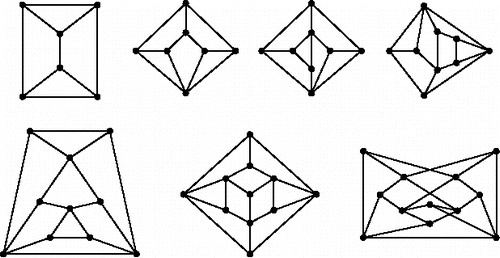
Table 2. Minimal and maximal Laman number among all n-vertex Laman graphs; the minimum is 2n − 2 and it is achieved, for example, on Laman graphs that are constructible by using only Henneberg steps of type 1. The row labeled with “lower” contains the bounds from [CitationEmiris et al. 09].
There are 44,176,717 Laman graphs with 12 vertices, and therefore it was a major undertaking to compute the Laman numbers of all of them; it took 56 processor days to complete this task. Hence, it is unrealistic to do the same for all Laman graphs with 13 or more vertices. In order to proceed further, we developed some heuristics to construct graphs with very high Laman numbers, albeit not necessarily the highest one. The properties that we formulate for the families T(n) and S(n) below are inspired by inspecting the few known graphs that achieve the maximal Laman number M2(n) (see and ). More precisely, we consider the set T(n) of Laman graphs with n vertices that satisfy the following additional properties.
Definition 3.
We say that a Laman graph G = (V, E) with n vertices is an element of T(n) iff
G is a planar graph, that is, it can be embedded in the plane without crossings of edges.
Each vertex of G has degree 3 or 4; in this case the Laman condition (Definition 1) implies that there are exactly 6 vertices of degree 3 and
vertices of degree 4.
There are precisely two 3-cycles, and the number of 4 cycles is
. Note that we count only nontrivial cycles all of whose edges are distinct. Moreover, the 3-cycles are disjoint, that is, they do not share an edge. By Euler's formula the number of faces (including the outer, unlimited one) is given by
, and hence each of the cycles is the boundary of a face.
These properties are quite selective: for example, the set T(12) contains only 18 (out of 44 million!) Laman graphs, and the set T(18) has the manageable cardinality 188. For n ⩽ 11 we have that . In contrast, the 12-vertex graph with the highest Laman number is not in T(12), since it is not planar and does not have any 3-cycles. Nevertheless, it satisfies the condition on the vertex degrees. Furthermore, the graph with the highest Laman number in T(12) is the graph with the second highest Laman number with 12 vertices. Hence, it is also the graph with the highest Laman number which does contain a 3-cycle. For 13 ⩽ n ⩽ 18, we have constructed all Laman graphs T(n) and among them identified the one with the highest Laman number. We summarize the results in ; the corresponding graphs are displayed in .
Table 3. With MT(n) we denote the maximal Laman number of the graphs in T(n). In the row below we give the highest Laman numbers that we have found so far by looking at graphs in S(n) (exhaustive for n ⩽ 15 but incomplete for n > 15).
We have seen that for 12 vertices the maximal graph in T(12) is not the one with the highest Laman number. The same holds true for 13 ⩽ n ⩽ 18, which can be seen by looking at a different family of graphs: We observed that the graphs which are known to be maximal according to their Laman number are Hamiltonian, i.e., they contain a path that visits each vertex exactly once (Hamiltonian path). Hence, we focus on Hamiltonian graphs. The problem is that they cover still around 2/3 of all Laman graphs (at least for small n). Therefore, we considered other properties of the known graphs with maximal Laman number. One of these properties is the symmetry of a certain embedding.
Definition 4.
We say that a Laman graph G = (V, E) is an element of S(n) iff
G is Hamiltonian, i.e., it contains a Hamiltonian cycle H.
There exists a circular embedding, i.e., an embedding ρ such that ρ(v) lies on the same circle for all v ∈ V, and H is embedded on a regular n-gon.
The figure obtained by the embedding is point, resp., line symmetric for an even, resp., odd number of vertices.
One can see that the maximal Laman graphs up to 12 vertices fulfill these symmetry properties ().
We computed the Laman numbers of all graphs in S(n) up to n = 15. Unfortunately, for larger n the set S(n) still contains too many graphs. For n = 15 there are already 85,058 such graphs. Performing the computations on a subset of S(n) yields the graphs shown in .
2.3. Lower bounds
We now use these results to derive new and better lower bounds than the previously known ones. We apply the caterpillar construction to the Laman graphs with the maximal number of embeddings for 6 ⩽ n ⩽ 12, and for 13 ⩽ n ⩽ 18 we use the graphs found by exploring the set S(n) (see and ). The fan construction is applied to the maximal Laman graphs for 6 ⩽ n ⩽ 11 only, since it is not applicable to the maximal graph with 12 vertices (). Hence, for the remaining cases, 12 ⩽ n ⩽ 18, the fan construction is applied to the maximal graph in T(n). In , the results obtained by these graphs are written in a separate column. The results in the next column are obtained by randomly found graphs which contain a triangle and have a higher Laman number than the one in T(n).
Table 4. Growth rates (rounded) of the lower bounds. For n ⩽ 12 these values are proven to be the best achievable ones; for n > 12 the values are just the best we found by experiments, hence it is possible that there are better ones. The drawings of the graphs corresponding to the last three columns are given in . The encodings for the graphs can be found at: caterpillar (), fan T(n) (), fan (), 31-fan (), 254-fan (), 223-fan and 239-fan (), 7916-fan ().
For 7 ⩽ n ⩽ 11, we also tried the generalized fan construction: among all Laman graphs whose vertex degrees are at least 3—we can exclude Laman graphs that have vertices of degree 2 since they can be derived from a smaller graph by Henneberg steps of type 1, thereby only doubling the embedding number—we selected all graphs that have the four-vertex Laman graph as a subgraph. Then we computed their Laman numbers in order to find the maximum that can be achieved among those graphs. Until 12 vertices the lower bounds, according to (Equation3(3)
(3) ), are not as good as those obtained by the standard fan construction. For higher n, randomly found graphs show improvements over the fan construction for the graphs we have found. Note that since the graphs are found only randomly this does not show any results on whether the factors are indeed better.
From (), we can see the bound 2.28943n obtained in [CitationBorcea and Streinu 04], 2.30033n from [CitationEmiris and Moroz 11], and 2.41159n from [CitationJackson and Owen 18], as well as the current improvements obtained in this paper. By instantiating Formula (Equation2(2)
(2) ) with the last Laman graph in , which has 18 vertices and Laman number 1953816, we obtain the following theorem.
Figure 7. Laman graphs in T(n) with 12 ⩽ n ⩽ 18 vertices; for each n the graph with the largest Laman number among the Laman graphs in T(n) is displayed. The corresponding Laman numbers are given in (encodings see ).
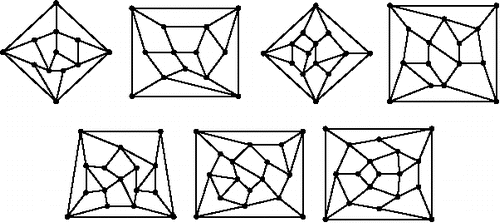
Figure 8. Circular embedding of the Laman graphs with maximal Laman numbers for 6 ⩽ n ⩽ 12. Note that these are the same graphs that are displayed in .
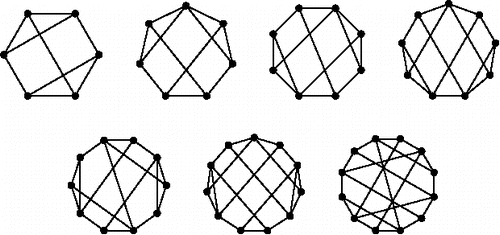
Figure 9. For n = 13, …, 18, we display the graph from S(n) with the highest Laman number (given in ) found so far (encodings see ).

Figure 10. Laman graphs with 7 ⩽ n ⩽ 12 vertices that have the four-vertex Laman graph (encoded as 31) as a subgraph; below their Laman numbers are given. In some cases, there are several Laman graphs with this subgraph property and with the same Laman number, but among all Laman graphs that have this subgraph there does not exist one with higher Laman number (encodings see ).
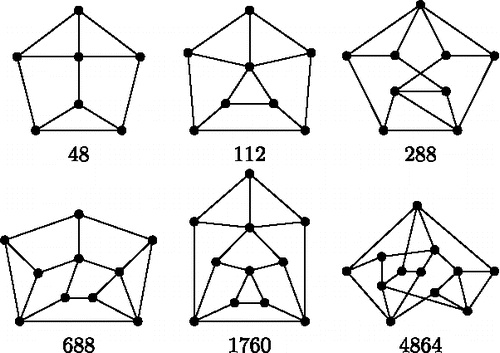
Figure 11. Growth rates of the lower bounds (red = caterpillar construction, blue = fan construction, green = 31-fan construction, fuchsia = 254-fan construction, brown = 7916-fan construction). The light colors indicate values that were not found by exhaustive search and which therefore could possibly be improved.

Theorem 5.
The maximal Laman number M2(n) satisfies
This means M2(n) grows at least as
, which is approximately 2.50798n. In other words
.
3. Dimension 3
A generalization of the counting condition to three dimensions would suggest that a graph G = (V, E) needs to fulfill |E| = 3|V| − 6, and |E′| ⩽ 3|V′| − 6 for every subgraph G′ = (V′, E′) of G in order to be rigid. Unlike the two-dimensional case, this definition is necessary but not sufficient for generic minimal rigidity. An example of a graph which is not minimally rigid in dimension 3 can already be found in [CitationPollaczek-Geiringer 27]. We are interested in lower bounds on M3(n), which is the three-dimensional analog of M2(n).
Definition 6.
Let G = (V, E) be a graph. We call G a Geiringer graph,Footnote1 if there exists only a finite number of (complex) spatial embeddings in , given a generic labeling
of the edges of G.
For a Geiringer graph G, we define Lam3(G), called the 3D-Laman number of G, to be this finite number of (complex) embeddings. Moreover, we define M3(n) to be the largest 3D-Laman number that is achieved among all Geiringer graphs with n vertices.
In [CitationTay and Whiteley 85], Geiringer graphs are shown to be constructible from a triangle graph by a sequence of three types of steps (see ). Steps of type 1 and type 2 preserve rigidity (see [CitationTay and Whiteley 85]). The steps of type 3 can be further classified according to whether the two chosen edges have a common vertex or not. Note that every Geiringer graph can be constructed using such steps [CitationTay and Whiteley 85, Prop. 4.1, 4.4, 4.5], but not every construction by these steps is indeed minimally rigid, i.e., rigidity is not necessarily preserved by steps of type 3. Indeed type 3v does not even preserve the vertex-edge-count for subgraphs (see ). However, there are certain subclasses of type 3 steps for which rigidity is preserved (see, for instance, [CitationTay and Whiteley 85, CitationGraver et al. 93, CitationCruickshank 14]).
Figure 12. Henneberg steps of different types in dimension 3; a dashed line indicates that this edge can exist but does not need to.
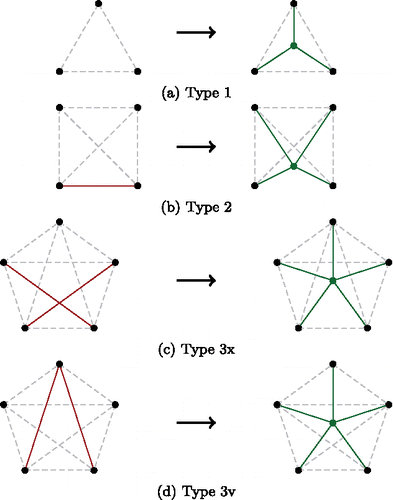
In the following, we construct Geiringer graphs by the above-mentioned moves, removing those which turn out to be non-rigid. By this procedure, we get all Geiringer graphs with up to 10 vertices. The computation of the number of realizations is done by Gröbner bases: The coordinates of the vertices are obtained as the solutions of a system of (quadratic) polynomial equations. Instead of keeping the edge lengths generic (by introducing a symbolic parameter for each edge), we insert random numbers (integers) for the edge lengths. Otherwise the computation would not be feasible at all. Moreover, for further speed-up, we compute the Gröbner basis only modulo a sufficiently large prime number p so that the occurrence of large rational numbers is avoided. In other words, the Gröbner basis computation takes place over the finite field . In order to get high confidence into the results, we did each computation at least three times, with different random choices of the parameters. If we get the same result three times, we can be rather sure to have the correct number. However, we want to make the reader aware of the fact, that it is a probabilistic method. Although we have a strong evidence for the computed 3D-Laman numbers, they are not rigorously proven to be correct.
Still, computing the 3D-Laman numbers for all Geiringer graphs of 10 vertices was a major undertaking. By applying the Henneberg steps depicted in in all possible ways, we obtained 747,065 graphs that potentially had the property of being minimally rigid (our Gröbner basis computations suggested that 612,884 of them indeed have this property). In our implementation, we do some preprocessing on the graphs in order to create polynomial systems with as few variables as possible: for example, we remove vertices of valency 3 (i.e., revert Henneberg steps of type 1), and compensate by multiplying the final Laman number by 2 for each removed vertex. Another optimization consists in identifying the largest tetrahedral subgraph, i.e., the largest subgraph that can be constructed by Henneberg steps of type 1, starting from a triangle. This subgraph is considered when fixing some vertices of the graph, in order to deal with rotations and translations. Then we call the fast FGb [CitationFaugère 10] implementation of Gröbner bases in Maple, for determining the number of solutions of the constructed polynomial system. Executing this program once for all 747,065 graphs took about 162 days of CPU time, using Xeon E5-2630v3 Haswell 2,4Ghz CPUs. However, the computations were run in parallel so that the result was obtained after a few days. This means that in average it took about 19 s to determine the 3D-Laman number of a graph with 10 vertices, but the timings vary a lot: graphs which can be constructed by Henneberg steps of type 1 require almost no time, due to our preprocessing, while the Gröbner basis computation for some graphs takes several hours (up to 16 hours).
It is easy to see that a Henneberg step of type 1 always increases the 3D-Laman number by a factor of 2. So far it is not known by which factor a Henneberg step of type 2 or type 3 might increase the 3D-Laman number. summarizes some increases of 3D-Laman numbers, given a certain Geiringer graph G and constructing a new one G′ by a single Henneberg step.
Table 5. Henneberg constructions and increase of 3D-Laman numbers.
3.1. Constructions
We consider again caterpillar and fan constructions. For the caterpillar we now need to glue two graphs by a common triangle. Similarly, we need a tetrahedron for the fan construction. For the generalized fan construction, we use the unique Geiringer graph with five vertices. For sake of completeness, we display the general formula for obtaining a lower bound on M3(n) with the generalized 3D-fan construction; the formula is completely analogous to (Equation3(3)
(3) ):
(4)
(4)
3.2. Lower bounds for M3(n)
In orderto get good lower bounds, we need particular Geiringer graphs that have a large number of embeddings. We computed the 3D-Laman numbers of all Geiringer graphs with up to n = 10 vertices. For each n, we have identified the (unique) Geiringer graph with the highest number of embeddings. These numbers are given in . The corresponding graphs for 6 ⩽ n ⩽ 10 are shown in .
Figure 14. Geiringer graphs with 6 ⩽ n ⩽ 10 vertices; for each n the (unique) graph with maximal number of embeddings is depicted. The corresponding 3D-Laman numbers M3(n) are given in (encodings see ).

Figure 15. Growth rates of the lower bounds (red = caterpillar construction, blue = fan construction, green = generalized fan construction).
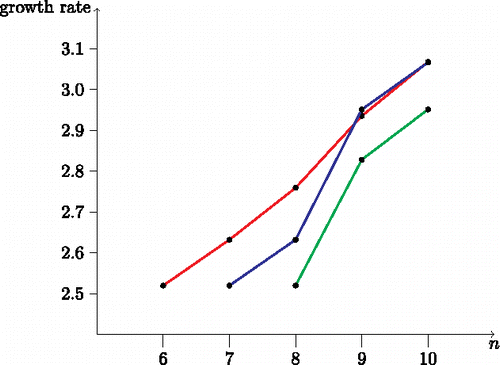
Table 6. Minimal and maximal 3D-Laman number among all n-vertex Geiringer graphs; the row labeled with “min” contains the lowest 3D-Laman number which is found by computation. The row labeled with “upper” contains the bounds from [CitationBorcea and Streinu 04].
In [CitationEmiris et al. 09], lower and upper bounds for the 1-skeleta of simplicial polyhedra are computed. They also use an extension of Henneberg steps to the three-dimensional case. However, they form just a subset of the Henneberg steps presented here. From (), we can see the bound of 2.51984n obtained in [CitationEmiris et al. 09] and the improvements obtained in this paper. By instantiating Formula (Equation4(4)
(4) ) with the last Laman graph in , which has 10 vertices and 3D-Laman number 2560, we obtain the following theorem.
Table 7. Growth rates (rounded) of the lower bounds. The encodings for the graphs can be found at: caterpillar (), fan (), generalized fan ().
Table 8. Graph encodings for the graphs with maximal Laman number (see ).
Table 9. Graph encodings for the graphs in T(n) (see ).
Table 10. Graph encodings for the graphs in S(n) from .
Table 11. Graph encodings for graphs which contain the triangle as subgraph and have high Laman number.
Table 12. Graph encodings for the graphs from and further graphs which contain the 4-vertex Laman graph as subgraph and have high Laman number.
Table 13. Laman graphs which have the 5-vertex graph with encoding 254 as subgraph.
Table 14. Laman graphs which have the 5-vertex graph with encoding 223 and 239 as subgraph, respectively.
Table 15. Laman graphs which have the three-prism with encoding 7916 as subgraph.
Table 16. Graph encodings for the Geiringer graphs with maximal 3D-Laman number (see ).
Table 17. Graph encodings for the Geiringer graphs which contain the tetrahedron.
Table 18. Graph encodings for the Geiringer graphs which contain the double tetrahedron.
Theorem 7.
The maximal Laman number M3(n) satisfies
This means M3(n) grows at least as
which is approximately 3.06825n. In other words
.
4. Conclusion
By exploiting state-of-the-art methods, we gave some new bounds on the maximal possible number of realizations of rigid graphs for a given number of vertices. Further systematic computations would exceed reasonable time constraints. The results obtained by our analysis give of course rise to further research. It is still an open problem how graphs which have the maximal number of realizations can be classified, and how to bound this number:
Open Problem 1.
Find an upper bound bn < 4n − 2 such that Lam2(G) ⩽ bn for all Laman graphs G with n vertices.
From our data, we observe that (for n ⩽ 12) there is always a unique graph Gn, max on n vertices that achieves the maximal Laman number among all graphs with n vertices.
Conjecture 2.
For each n ⩾ 2, there is a unique Laman graph Gn, max with n vertices and with the property Lam2(Gn, max ) = M2(n). Similarly for M3(n).
Also the relation of Henneberg steps to the increase of the number of realizations is subject of further research:
Open Problem 3.
Find lower and upper bounds for the factor where G′ is constructed for a Laman graph G by a Henneberg step. By what we showed, the lower bound is smaller than or equal to 12/7 in 2D and 1/4 in 3D. The upper bound is bigger than or equal to 301/32 in 2D and 68/3 in 3D.
In dimension 2, we expect every Henneberg step to increase the Laman number by at least a factor of two. As mentioned above, this is still open for steps of type 2c.
Conjecture 4.
For a Laman graph G with n vertices we have Lam2(G) ⩾ 2n − 2.
In dimension 3, this does definitely not hold any more, since the first line in gives a counterexample. It would be interesting to know whether there is a lower bound on the Laman number in 3D.
Another direction of research is the study of real realizations, i.e., by considering labelings λ whose values are in and embeddings into
. In the 2D case, it is known that the ratio between the number of real and complex realizations can be arbitrarily close to 0, by exhibiting a particular graph (of eight vertices and Laman number 90), which provably cannot have as many real realizations as complex ones [CitationJackson and Owen 18], and by gluing this graph arbitrarily often together.
Open Problem 5.
Let R2(G) be the maximal (finite) number of different real realizations in of a Laman graph G = (V, E), that can be achieved for some real labeling
. Clearly, for a Laman graph G that is constructible by using only Henneberg steps of type 1, we have R2(G) = Lam2(G). But what can we say about the sequence
of quotients
i.e., we are asking about the gap between real and complex realizations for graphs with maximal Laman number. From [CitationEmiris and Moroz 11] we know that ϕn = 1 for n ⩽ 7, but does ϕn = 1 hold for all n? Probably not. Do we have limn → ∞ϕn = 0, or does this limit approach a nonzero constant? Does the limit exist at all?
Similar questions can be posed for the three-dimensional case, where much less is known. A first step into this direction would be to answer the following question:
Open Problem 6.
Find a Geiringer graph that cannot have as many real realizations as complex realizations.
Additional information
Funding
Notes
1 As Hilda Pollaczek-Geiringer had already worked on rigid graphs in 2D and 3D [CitationPollaczek-Geiringer 27, CitationPollaczek-Geiringer 32], long before Gerard Laman [CitationLaman 70].
References
- [Borcea and Streinu 04] C. Borcea and I. Streinu. “The Number of Embeddings of Minimally Rigid Graphs.” Discrete. Comput. Geom. 31 (2004), 287–303.
- [Capco et al. 16] J. Capco, M. Gallet, G. Grasegger, C. Koutschan, N. Lubbes, and J. Schicho. Electronic Supplementary Material for the Paper “The Number of Realizations of a Laman Graph.” Available online (http://www.koutschan.de/data/laman/), 2016.
- [Capco et al. 17a] J. Capco, M. Gallet, G. Grasegger, C. Koutschan, N. Lubbes, and J. Schicho. “Computing the Number of Realizations of a Laman Graph.” Electr. Notes Discr. Math. 61 (2017), 207–213. The European Conference on Combinatorics, Graph Theory and Applications (EUROCOMB’17).
- [Capco et al. 17b] J. Capco, M. Gallet, G. Grasegger, C. Koutschan, N. Lubbes, and J. Schicho. “The Number of Realizations of a Laman Graph.” SIAM J. Appl. Alg. Geom. (2017). arXiv:1701.05500.
- [Cruickshank 14] J. Cruickshank. “On Spaces of Infinitesimal Motions and Three Dimensional Henneberg Extensions.” Discrete Comput. Geom. 51: 3 (2014), 702–721.
- [Emiris and Moroz 11] I. Z. Emiris and G. Moroz. The Assembly Modes of Rigid 11-bar Linkages. IFToMM 2011 World Congress, Guanajuato, Mexico, June 19–25, 2011. arXiv:1010.6214.
- [Emiris and Mourrain 99] I. Z. Emiris and B. Mourrain. “Computer Algebra Methods for Studying and Computing Molecular Conformations.” Algorithmica, Spec. Issue Algo. Comput. Biol. 25 (1999), 372–402.
- [Emiris et al. 13] I. Z. Emiris, E. P. Tsigaridas, and A. Varvitsiotis. “Mixed Volume and Distance Geometry Techniques for Counting Euclidean Embeddings of Rigid Graphs.” In Distance Geometry, edited by A. Mucherino, C. Lavor, L. Liberti and N. Maculan, pp. 23–45. New York: Springer, 2013.
- [Emiris et al. 09] I. Z. Emiris, E. P. Tsigaridas, and A. E. Varvitsiotis. “Algebraic Methods for Counting Euclidean Embeddings of Graphs.” In Graph Drawing: 17th International Symposium, edited by D. Eppstein and E. R. Gamsners, pp. 195–200. New York: Springer, 2009.
- [Emmerich 88] D. G. Emmerich. Structures tendues et autotendantes. Ecole d’Architecture de Paris La Villette, 1988.
- [Faugère 10] J. C. Faugère. “FGb: A Library for Computing Gröbner Bases.” In Mathematical Software - ICMS 2010, volume 6327 of Lecture Notes in Computer Science, edited by K. Fukuda, J. van der Hoeven, M. Joswig and N. Takayama, pp. 84–87. Berlin Heidelberg: Springer, 2010.
- [Faugère and Lazard 95] J. C. Faugère and D. Lazard. “The Combinatorial Classes of Parallel Manipulators Combinatorial Classes of Parallel Manipulators.” Mech. Mach. Theo. 30: 6 (1995), 765–776.
- [Graver et al. 93] J. Graver, B. Servatius, and H. Servatius. Combinatorial Rigidity. Providence, RI: American Mathematical Society, 1993.
- [Henneberg 03] L. Henneberg. “Die graphische Statik der starren Körper.” In Encyklopädie der mathematischen Wissenschaften mit Einschluss ihrer Anwendungen, edited by F. Klein and C. Müler, vol. IV, pp. 345–434. Leipzig: B. G. Teubner, 1903.
- [Jackson and Owen 18] B. Jackson and J. C. Owen. “Equivalent Realisations of A Rigid Graph.” Disc. Appl. Math., 2018. DOI:10.1016/j.dam.2017.12.009.
- [Jacobs et al. 01] D. J. Jacobs, A. J. Rader, L. A. Kuhn, and M. F. Thorpe. “Protein Flexibility Predictions using Graph Theory.” Prot. Struct. Funct. Genet. 44: 2 (2001), 150–165.
- [Laman 70] G. Laman. “On Graphs and Rigidity of Plane Skeletal Structures.” J. Eng. Math. 4 (1970), 331–340.
- [Liberti et al. 11] L. Liberti, C. Lavor, A. Mucherino, and N. Maculan. “Molecular Distance Geometry Methods: From Continuous to Discrete.” Int. Trans. Operat. Res. 18: 1 (2011), 33–51.
- [Liberti et al. 14] L. Liberti, B. Masson, J. Lee, C. Lavor, and A. Mucherino. “On the Number of Realizations of Certain Henneberg Graphs Arising in Protein Conformation.” Disc. Appl. Math. 165 (2014), 213–232.
- [Mucherino et al. 12] A. Mucherino, C. Lavor, L. Liberti, and N. Maculan. Distance Geometry: Theory, Methods, and Applications. New York: Springer Science & Business Media, 2012.
- [Pollaczek-Geiringer 27] H. Pollaczek-Geiringer. “Über die Gliederung ebener Fachwerke.” Z. Angew. Math. Mech. (ZAMM) 7: 1 (1927), 58–72.
- [Pollaczek-Geiringer 32] H. Pollaczek-Geiringer. “Zur Gliederungstheorie räumlicher Fachwerke.” Z. Angew. Math. Mech. (ZAMM) 12: 6 (1932), 369–376.
- [Steffens and Theobald 10] R. Steffens and T. Theobald. “Mixed Volume Techniques for Embeddings of Laman Graphs.” Comput. Geom. 43: 2 (2010), 84–93.
- [Tay and Whiteley 85] T.-S. Tay and W. Whiteley. “Generating Isostatic Frameworks.” Topol. Struct. 11 (1985), 21–69.
- [Walter and Husty 07a] D. Walter and M. L. Husty. “On a 9-bar Linkage, its Possible Configurations and Conditions for Paradoxical Mobility.” IFToMM World Congress 2007, Besançon, France, June 17–21, 2007.
- [Walter and Husty 07b] D. Walter and M. L. Husty. “A Spatial 9-bar Linkage, Possible Configurations and Conditions for Paradoxical Mobility.” NaCoMM, Bangalore, India, pp. 195–208, December 12–13, 2007.
- [Zhu 10] Z. Zhu, A. M.-C. So, and Y. Ye. “Universal Rigidity and Edge Sparsification for Sensor Network Localization.” SIAM J. Optim. 20: 6 (2010), 3059–3081.
Appendix—Graph encodings
In thissection, we present details on our graph encodings and collect the encodings of the graphs explaining the results and observations in the main part.
We represent a graph by the integer that is obtained by flattening the upper right triangle of its adjacency matrix and interpreting this binary sequence as an integer. Note that the adjacency matrix will always have zeros on the main diagonal, and hence we consider only entries above the main diagonal.
Note, that isomorphic graphs might be represented by different numbers in this way. Hence, for our computations we used some normal form, which is not necessary to explain in detail here. The conversion from a number to a graph does not depend on this normal form.



